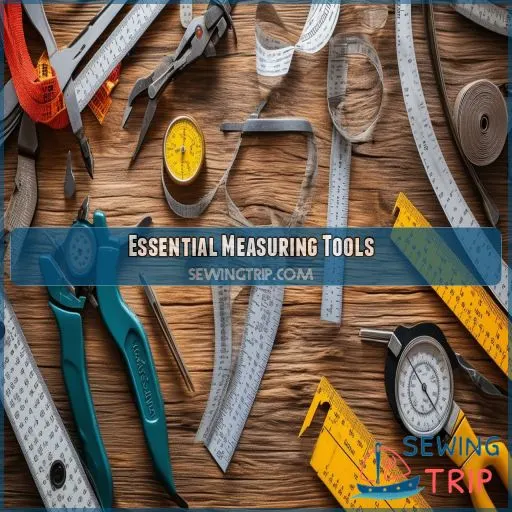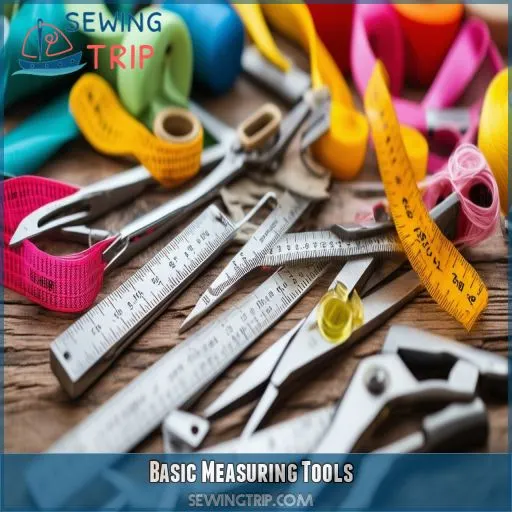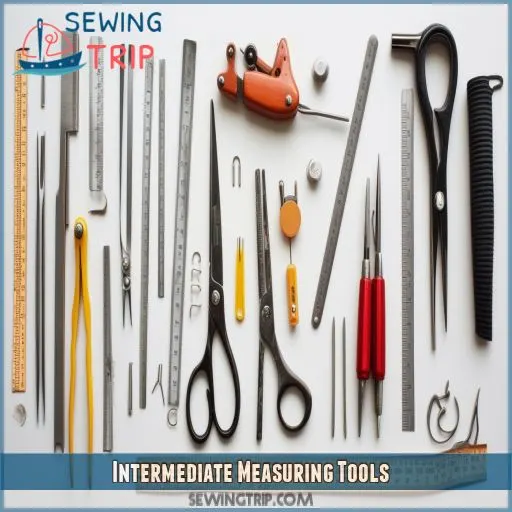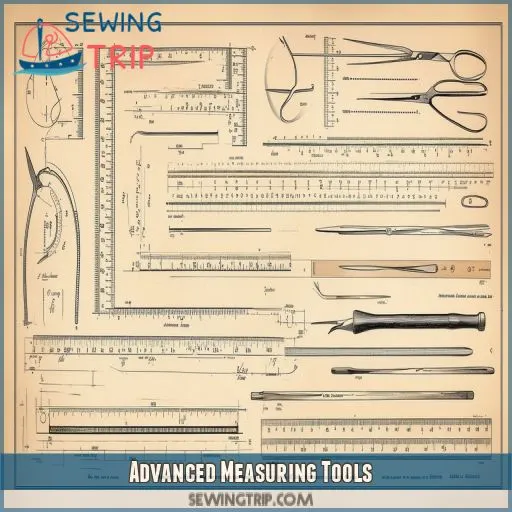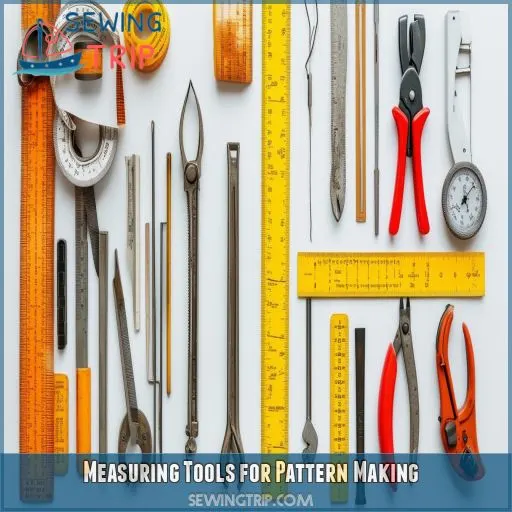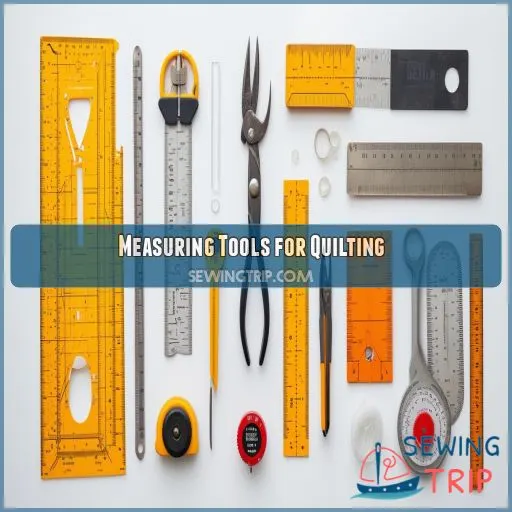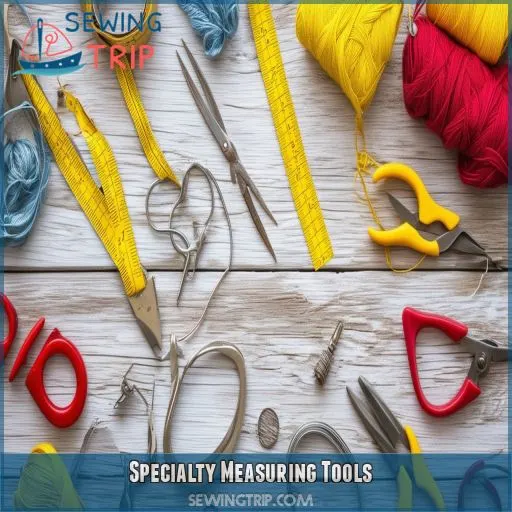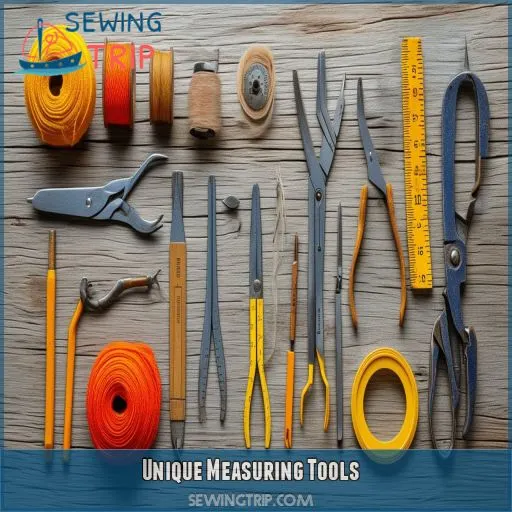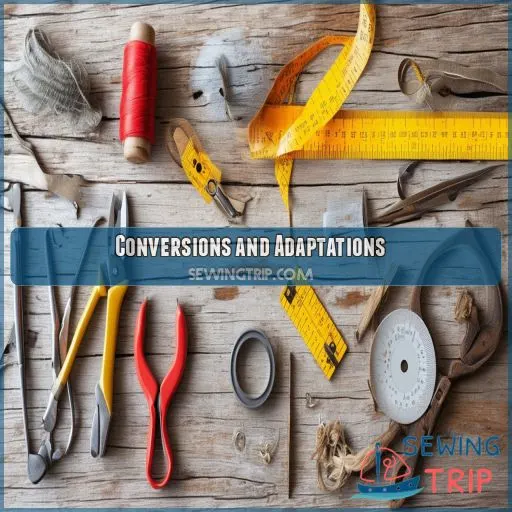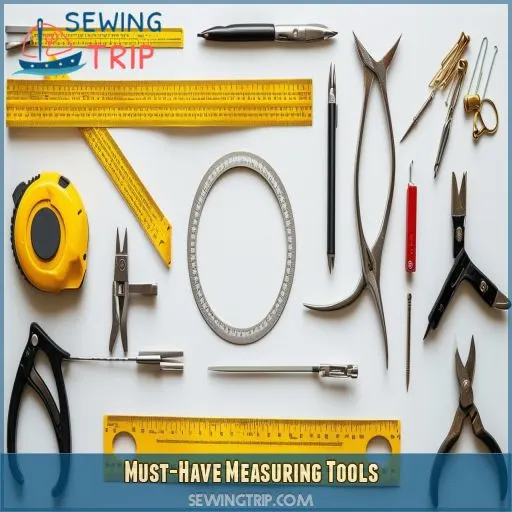This site is supported by our readers. We may earn a commission, at no cost to you, if you purchase through links.
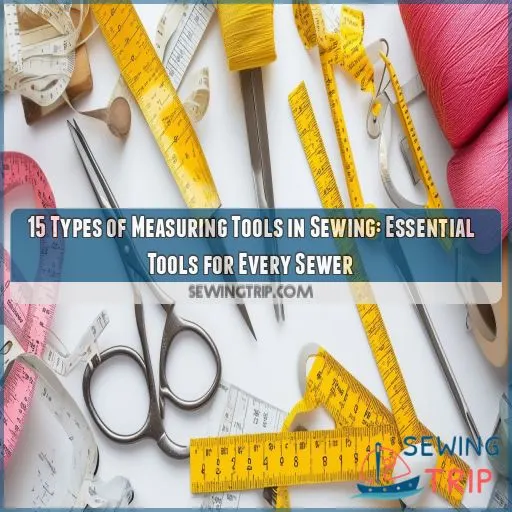
In "15 Types of Measuring Tools in Sewing: Essential Tools for Every Sewer," you will learn about indispensable tools for accurate measurements from basic tape measures to advanced pattern-making rulers that are sure to help you turn your fabric into a work of art.
Let’s discuss these must-have Sewing Essentials to make everything accurate and successful.
Table Of Contents
- Key Takeaways
- Essential Measuring Tools
- Basic Measuring Tools
- Intermediate Measuring Tools
- Advanced Measuring Tools
- Measuring Tools for Pattern Making
- Measuring Tools for Quilting
- Specialty Measuring Tools
- Unique Measuring Tools
- Conversions and Adaptations
- Must-Have Measuring Tools
- Frequently Asked Questions (FAQs)
- Conclusion
Key Takeaways
- Measuring tools are like the secret ingredients in a recipe; they’re essential for sewing success!
- From tape measures to digital tools, there’s a measuring tool for every task, so you’ll never be left hanging.
- Don’t be a square! Use a French curve ruler to add some flair to your patterns and garments.
- Invest in quality measuring tools because they’re the backbone of any sewing project and will help you avoid costly mistakes.
Essential Measuring Tools
Having the tape measure first provided you with the ways of measuring around curves and lengths, which can be amazingly useful in accuracy.
Quilting rulers have equally useful clear grid lines designed for making straight cuts and angles. A hem gauge adjustable and precise provides a method one will have to take hems confidently.
French curves and flexible rulers are great for ensuring smooth lines when working on ergonomic design.
The digital measuring tools and smart measuring devices for more tech-savvy people can give accuracy like never before. Quality and tool precision are the way to go, so invest in these core tools and help take your sewing projects from good to great. Your craftsmanship will thank you for that.
Basic Measuring Tools
Moving on from vital tools, let’s talk about Basic Measuring Tools—tools any sewing kit will find it hard to do without. These simple tools ensure accuracy and speed in your projects.
- Flexible Tape Measure: Used for taking body measurements and measuring fabrics.
- Clear Ruler: This is an excellent tool for pattern drafting and lining up seams.
- Yardstick: Perfect for larger pieces of fabric, these give you long, straight measurements.
- Sewing Gauge: A small ruler with a sliding marker, the best for marking hems and seam allowances.
- Measuring Gauge: The sewing gauge may be similar but normally more supple and useful for fine adjustments.
With these tools, you’re all set for sewing with precision and mastery.
Intermediate Measuring Tools
Moving beyond these basic measuring tools, there’s a whole new world of intermediate options that can really bring your sewing to life. First, there’s a French curve ruler that helps you in creating smooth lines when drafting collars, armholes, and other curved areas in detail. Then there’s the ring ruler, quite useful for measuring the circumference of buttons, cuffs, and other such round elements on garments.
| Tool | Use |
|---|
Tailor’s L Square: Ensures the perfect right angles for pattern pieces.
These intermediate tools, along with the basics, grant the sewist powers to effectively and precisely work through a wide range of projects. Embrace this versatility, and watch your craft grow into new dimensions of mastery.
Advanced Measuring Tools
When you’re really comfortable with the intermediate tools, plunge in to the advanced measuring tools. The operative word here will be precision measuring.
Tools like the pattern master bring multifaceted utility by collating several curves and scales for intricate work. Digital measuring tools and laser distance measurement devices provide exact measurements that are indispensable to large projects.
With a ring ruler, you can creatively attack circular patterns with confidence. The flexible curve rule bends to any curved seam, while a curve runner is useful in the measurement of irregular paths.
On top of that, don’t forget about a hemline gauge, which helps you have equal seam allowances. Keeping these special scales in good working order involves regular cleaning and calibration.
These tools will give your sewing projects a run for their money in terms of precision and professionalism.
Measuring Tools for Pattern Making
Correct measuring tools can help you make things easier and results more accurate while drafting your first pattern designs. Start with a grading ruler or L-square ruler to facilitate drawing straight lines and angles accurately.
A flexible curved ruler or a French curve ruler will assist you in armhole curves and other curved templates. Measuring gauge comes in handy for checking small distances and seam allowances.
Don’t forget to add in a cutting mat—this will keep your work area safe and your tools sharp. Having the correct rulers, such as a hip curve or curve runner, on occasion makes all the difference when making a template. Critical tools, these help you achieve pattern designs accurate and professional enough to sew up.
Measuring Tools for Quilting
Accuracy above all is key while quilting. Begin with quilting rulers so that you have perfect cuts and measurements for your patterns.
Gridded quilting rulers and square quilting rulers help you stay very close to the accuracy required in your patterns.
A cutting mat provides a stable surface when using rotary cutters.
By using triangle and shaped quilting rules, like the triangle quilting ruler, for angles, create sharp and well-defined edges.
Think about a hem gauge just for measuring the seam allowance and a heat-resistant ruler for pressing and marking.
An expanding sewing gauge makes the tool flexible when repeating operations; a folding ruler is convenient to carry around.
Not to mention, don’t hesitate over using a normal ruler or a seam gauge if you just want to make some simple measurements.
Tools should be kept nearby to ensure every quilt is accurately pieced.
Specialty Measuring Tools
Specialty sewing measurement tools mean attention for special applications or niche uses that provide precision, a boost to your creativity. One simple example includes the Fashion Curve and French Curve Ruler; both are used in making complex patterns or lines. In tailoring custom clothing, these rulers play a very important role. The hip curve ruler takes accurate measuring for hips and thighs to ensure perfect fittings on clothes.
A button gauge will ensure closely spaced, similarly sized buttons, really placing that final professional touch into your work. All of these specialty tools can seem a bit pricey when this investment is added, but the cost of these specialty tools is very well spent money for the accuracy and time saved in having one of these tools. For you DIYers, this can allow you to do more intricate designs confidently and create a more polished result.
Unique Measuring Tools
Stepping away from specialty tools, let’s now discuss some unusual measuring tools to help take your sewing to the next level.
The sewing seam gauge or buttonhole gauge will be useful for the precision of putting darts. For measuring curves, a flexible curved ruler or French curve will do the trick. Bias cuts should be made with a yardstick to ensure straight and correct lines.
Compasses and protractors provide faultless angles and spacing when doing quite tricky tucks and gathers; buttonhole gauges will show you in a flash where to place buttons, and a protractor will help measure out specific angles in a hurry.
Only these few special tools may seem specialized, but they’ll help tame some of those really problematic techniques: darts, curves, bias cuts, pleats, and gathers. Master these tools, and your sewing projects will go to a whole new level of accuracy and professional results.
Conversions and Adaptations
Every sewer has to deal with conversions and adaptations. If you’re constantly working back and forth with the imperial and metric systems, then a flexible tape measure marked in both units comes in handy.
A tailor’s L-square is very nice when one needs to be exact about moving patterns from one system to another. Another chart that’s helpful is sewing yardage conversion so you can easily figure out how much fabric to buy. There’s no need to worry about involved calculations, since transparent rules and L-squares make your task easier.
Together with that, metric conversions can help in case your patterns come from many diversified sources. As a result, by learning to work with the above tools and applying the above techniques, you can successfully alter any pattern to fit your requirements, thus being able to complete every sewing job both accurately and efficiently.
Must-Have Measuring Tools
While sewing, there are some measuring aids that become absolutely necessary for precision and efficiency. Here are the must-haves:
- Flexible rules: Perfect to measure curves and awkward angles.
- Hem gauges: This tool is quite useful in seam allowances and hems.
- Quilting rulers: Very useful to cut fabric pieces with accuracy for making quilts.
- Expanding gauges: Useful for spacing buttons and decorations.
- Cutting mats: They provide a clean, non-slip surface to cut fabric on.
Also, don’t forget about your yard stick and L-square ruler (or Tailor’s L-square) for larger measurements and to create right angles. The correct tools in measuring will help you easily make metric to imperial changes. These measuring must-haves see that all your projects go without any flaws.
Frequently Asked Questions (FAQs)
What are all the measuring tools in sewing?
In sewing, essential measuring tools include tape measures, clear rulers, yardsticks, sewing seam gauges, French curve rulers, flexible curved rulers, tailor’s L squares, hip curve rulers, cutting mats, button gauges, quilting rulers, and protractors.
What are 7 sewing tools?
You will need a tape measure, sewing seam gauge, French curve ruler, yardstick, clear ruler, and hem gauge on the basic level. All these tools are absolutely vital to have in order to obtain precise measurements for your patterns and to sew attractively finished garments.
What are 5 sewing tools?
You’ll want a flexible tape measure, clear ruler, yardstick, sewing seam gauge, and French curve ruler for all your sewing projects. These essential tools make measuring and pattern-making a breeze.
What are the 8 sewing tools?
Think of your sewing toolkit as a treasure chest. You’ll need a tape measure, clear ruler, yardstick, sewing seam gauge, French curve ruler, hip curve ruler, gridded quilting rulers, and protractors to achieve precision.
How do I care for my measuring tools?
To care for your sewing measuring tools, gently wipe them clean after each use. Store them in a dry place to prevent rust or damage. Handle with care to maintain their accuracy over time.
Are digital measuring tools better for sewing?
Digital measuring tools offer increased precision, efficiency, and ease-of-use, especially with complex measurements in sewing. They complement traditional tools, ensuring you achieve exact results, reducing errors and saving time (Source).
How do I store large rulers?
You might be interested to know that 52% of the sewists store their large rulers vertically. Keep them organized right where you need them by using a wall-mounted pegboard or hooks. You’ll save space and keep the rulers flat and undamaged.
Can I use non-sewing rulers for sewing?
You can use non-sewing rulers for sewing, but they’ll not be as accurate or hard-wearing. Only a ruler specifically designed for sewing and pattern making can ensure accuracy of measurement and durability.
Whats the best portable measuring tool for travel?
Your best portable measuring tool for travel is a flexible tape measure. It’s lightweight, compact, and versatile for all your sewing needs, whether measuring fabric, body dimensions, or patterns. You can easily slip it into any travel kit.
Conclusion
Ultimately, these 15 types of measuring tools in sewing are the most valuable things for any sewer aiming at producing a well-fitting garment. From the most basic tape measures to advanced pattern-making rulers, these necessary tools will go a great distance in getting you just the right measurements to turn your fabric into something really outstanding.
Whether one is a startup or a seasoned seamstress, knowing these 15 different types of measuring tools in sewing is what’ll unleash the creativity within.

